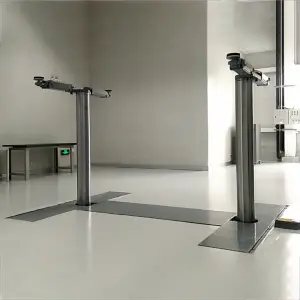[Cylinder]The Wonders of Cylinders: A Comprehensive Guide to
Cylinders are one of the most fascinating and versatile shapes found in our world. From everyday objects like cans and glasses to complex machinery like engines and turbines, cylinders play a crucial role in various aspects of our lives. In this article, we will explore the different characteristics and uses of cylinders, as well as the mathematical principles behind their shape.
A cylinder is a three-dimensional shape that consists of two parallel, congruent circular bases connected by a curved surface. The two bases are circles, and the curved surface is called the lateral surface. The height of a cylinder is the perpendicular distance between the two bases. Cylinders come in various sizes and proportions, making them a popular choice in architecture, engineering, and design.
One of the defining characteristics of cylinders is their volume. The volume of a cylinder can be calculated using the formula V = πr^2h, where r is the radius of the base and h is the height of the cylinder. This formula is derived from the fact that the volume of a cylinder is equal to the area of the base multiplied by the height. By knowing the radius and height of a cylinder, one can easily calculate its volume and make informed decisions about its capacity and dimensions.

The Wonders of Cylinders: A Comprehensive Guide to Understanding, Using, and Appreciating this Versatile Shape
Cylinders are commonly used in everyday objects such as cans, bottles, and tubes. The cylindrical shape of these containers allows for easy storage and transportation of liquids, gases, and solids. Cans of soda, for example, are made from cylindrical containers that can hold a specific volume of liquid. The cylindrical shape also makes it easy to stack and store these containers, maximizing space and efficiency.
In addition to their practical uses, cylinders are also widely used in engineering and machinery. Hydraulic cylinders, for example, are used in construction equipment, aerospace technology, and manufacturing processes. These cylinders use hydraulic fluid to generate force and motion, making them essential components in heavy machinery and mechanical systems. The precise design and construction of hydraulic cylinders allow for smooth and efficient operation, making them indispensable in various industries.

The Wonders of Cylinders: A Comprehensive Guide to Understanding, Using, and Appreciating this Versatile Shape
The concept of cylinders is not limited to physical objects – it also extends to abstract ideas and mathematical principles. In geometry, a cylinder is defined as a solid figure with two parallel bases that are congruent circles. The lateral surface of a cylinder is curved, forming a smooth and continuous shape. By understanding the properties of cylinders, mathematicians and scientists can solve complex problems and develop innovative solutions in various fields.

The Wonders of Cylinders: A Comprehensive Guide to Understanding, Using, and Appreciating this Versatile Shape
Overall, cylinders are a versatile and essential shape that plays a key role in our daily lives. From practical applications in containers and machinery to abstract concepts in geometry and mathematics, cylinders offer a wide range of possibilities and opportunities. By learning more about the characteristics and uses of cylinders, we can appreciate their beauty and functionality in our world. Whether it’s a can of soda or a hydraulic cylinder in a construction site, cylinders continue to shape our lives in profound and meaningful ways.k Lift Accessories